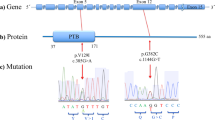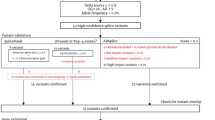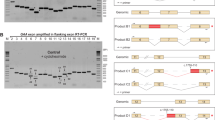Abstract
A large-scale sequencing screen of X-linked synaptic genes in individuals with autism spectrum disorder (ASD) or schizophrenia (SCZ), two common neurodevelopmental disorders, identified many variants most of which have no easily predictable effect on gene function. In this report, we evaluated the impact of these rare missense and silent variants on gene splicing. For this purpose, we used complementary in silico analyses, in vitro minigene-based assays and RNA prepared from lymphoblastoid cells derived from patients with these mutations. Our goal was to identify the variants which might either create or disrupt an acceptor splice site, a donor splice site or an exonic splicing enhancer, thus leading to aberrant splicing that could be involved in the pathogenesis of ASD or SCZ. We identified truncating mutations in distinct X-linked gamma-aminobutyric acid A (GABAA) receptor subunit-encoding genes, GABRQ and GABRA3, in two different families. Furthermore, missense and silent variants in nuclear RNA export factor 5 and histone deacetylase 6 were shown to partially disrupt the protein. While genes from the GABAergic pathway have previously been thought to be involved in the pathophysiology of ASD, this is the first report of ASD patients with truncating mutations in GABA receptors genes.
Similar content being viewed by others
Log in or create a free account to read this content
Gain free access to this article, as well as selected content from this journal and more on nature.com
or
References
Piton A, Michaud JL, Peng H et al: Mutations in the calcium-related gene IL1RAPL1 are associated with autism. Hum Mol Genet 2008; 17: 3965–3974.
Awadalla P, Gauthier J, Myers RA et al: Direct measure of the de novo mutation rate in autism and schizophrenia cohorts. Am J Hum Genet 2010; 87: 316–324.
Gauthier J, Champagne N, Lafrenière RG et al: De novo mutations in the gene encoding the synaptic scaffolding protein SHANK3 in patients ascertained for schizophrenia. Proc Natl Acad Sci USA 2010; 107: 7863–7868.
Girard SL, Gauthier J, Noreau A et al: Increased exonic de novo mutation rate in individuals with schizophrenia. Nat Genet 2011; 43: 860–863.
Xu B, Roos JL, Dexheimer P et al: Exome sequencing supports a de novo mutational paradigm for schizophrenia. Nat Genet 2011; 43: 864–868.
Skuse DH : X-linked genes and mental functioning. Hum Mol Genet 2005; 14 Spec No 1: R27–R32.
Laumonnier F, Cuthbert PC, Grant SG : The role of neuronal complexes in human X-linked brain diseases. Am J Hum Genet 2007; 80: 205–220.
Skuse D : Genetic influences on the neural basis of social cognition. Philos Trans R Soc Lond B Biol Sci 2006; 361: 2129–2141.
Goldstein JM, Seidman LJ, Goodman JM et al: Are there sex differences in neuropsychological functions among patients with schizophrenia? Am J Psychiatry 1998; 155: 1358–1364.
Fombonne E : Epidemiological trends in rates of autism. Mol Psychiatry 2002; 7 (Suppl 2): S4–S6.
Piton A, Gauthier J, Hamdan FF et al: Systematic resequencing of X-chromosome synaptic genes in autism spectrum disorder and schizophrenia. Mol Psychiatry 2010.
Flanagan SE, Patch AM, Ellard S : Using SIFT and PolyPhen to predict loss-of-function and gain-of-function mutations. Genet Test Mol Biomarkers 2010; 14: 533–537.
Cartegni L, Krainer AR : Disruption of an SF2/ASF-dependent exonic splicing enhancer in SMN2 causes spinal muscular atrophy in the absence of SMN1. Nat Genet 2002; 30: 377–384.
Bonnet C, Krieger S, Vezain M et al: Screening BRCA1 and BRCA2 unclassified variants for splicing mutations using reverse transcription PCR on patient RNA and an ex vivo assay based on a splicing reporter minigene. J Med Genet 2008; 45: 438–446.
Thery JC, Krieger S, Gaildrat P et al: Contribution of bioinformatics predictions and functional splicing assays to the interpretation of unclassified variants of the BRCA genes. Eur J Hum Genet 2011; 19: 1052–1058.
Eng L, Coutinho G, Nahas S et al: Nonclassical splicing mutations in the coding and noncoding regions of the ATM gene: maximum entropy estimates of splice junction strengths. Hum Mutat 2004; 23: 67–76.
Collin RW, de Heer AM, Oostrik J et al: Mid-frequency DFNA8/12 hearing loss caused by a synonymous TECTA mutation that affects an exonic splice enhancer. Eur J Hum Genet 2008; 16: 1430–1436.
Fukao T, Boneh A, Aoki Y, Kondo N : A novel single-base substitution (c.1124A>G) that activates a 5-base upstream cryptic splice donor site within exon 11 in the human mitochondrial acetoacetyl-CoA thiolase gene. Mol Genet Metab 2008; 94: 417–421.
Cartegni L, Chew SL, Krainer AR : Listening to silence and understanding nonsense: exonic mutations that affect splicing. Nat Rev Genet 2002; 3: 285–298.
Reese MG, Eeckman FH, Kulp D, Haussler D : Improved splice site detection in Genie. J Comput Biol 1997; 4: 311–323.
Cartegni L, Wang J, Zhu Z, Zhang MQ, Krainer AR : ESEfinder: a web resource to identify exonic splicing enhancers. Nucleic Acids Res 2003; 31: 3568–3571.
Desmet FO, Hamroun D, Lalande M, Collod-Beroud G, Claustres M, Beroud C : Human splicing finder: an online bioinformatics tool to predict splicing signals. Nucleic Acids Res 2009; 37: e67.
Yeo G, Burge CB : Maximum entropy modeling of short sequence motifs with applications to RNA splicing signals. J Comput Biol 2004; 11: 377–394.
Shapiro BA, Nussinov R, Lipkin LE, Maizel JV : An interactive dot matrix system for locating potentially significant features in nucleic acid molecules. J Biomol Struct Dyn 1987; 4: 697–706.
Fairbrother WG, Yeh RF, Sharp PA, Burge CB : Predictive identification of exonic splicing enhancers in human genes. Science 2002; 297: 1007–1013.
Zhang XH, Kangsamaksin T, Chao MS, Banerjee JK, Chasin LA : Exon inclusion is dependent on predictable exonic splicing enhancers. Mol Cell Biol 2005; 25: 7323–7332.
Li MZ, Elledge SJ : Harnessing homologous recombination in vitro to generate recombinant DNA via SLIC. Nat Methods 2007; 4: 251–256.
Allen RC, Zoghbi HY, Moseley AB, Rosenblatt HM, Belmont JW : Methylation of HpaII and HhaI sites near the polymorphic CAG repeat in the human androgen-receptor gene correlates with X chromosome inactivation. Am J Hum Genet 1992; 51: 1229–1239.
Burn TC, Connors TD, Klinger KW, Landes GM : Increased exon-trapping efficiency through modifications to the pSPL3 splicing vector. Gene 1995; 161: 183–187.
Bertos NR, Gilquin B, Chan GK, Yen TJ, Khochbin S, Yang XJ : Role of the tetradecapeptide repeat domain of human histone deacetylase 6 in cytoplasmic retention. J Biol Chem 2004; 279: 48246–48254.
Vreeswijk MP, Kraan JN, van der Klift HM et al: Intronic variants in BRCA1 and BRCA2 that affect RNA splicing can be reliably selected by splice-site prediction programs. Hum Mutat 2009; 30: 107–114.
Cooper TA : Use of minigene systems to dissect alternative splicing elements. Methods 2005; 37: 331–340.
Fiorelli R, Rudolph U, Straub CJ, Feldon J, Yee BK : Affective and cognitive effects of global deletion of alpha3-containing gamma-aminobutyric acid-A receptors. Behav Pharmacol 2008; 19: 582–596.
Yee BK, Keist R, von Boehmer L et al: A schizophrenia-related sensorimotor deficit links alpha 3-containing GABAA receptors to a dopamine hyperfunction. Proc Natl Acad Sci USA 2005; 102: 17154–17159.
Fatemi SH, Reutiman TJ, Folsom TD, Thuras PD : GABA(A) receptor downregulation in brains of subjects with autism. J Autism Dev Disord 2009; 39: 223–230.
Bonnert TP, McKernan RM, Farrar S et al: Theta, a novel gamma-aminobutyric acid type A receptor subunit. Proc Natl Acad Sci USA 1999; 96: 9891–9896.
Amaral DG, Schumann CM, Nordahl CW : Neuroanatomy of autism. Trends Neurosci 2008; 31: 137–145.
Pape JR, Bertrand SS, Lafon P et al: Expression of GABA(A) receptor alpha3-, theta-, and epsilon-subunit mRNAs during rat CNS development and immunolocalization of the epsilon subunit in developing postnatal spinal cord. Neuroscience 2009; 160: 85–96.
Bourgeron T : A synaptic trek to autism. Curr Opin Neurobiol 2009; 19: 231–234.
Hussman JP : Suppressed GABAergic inhibition as a common factor in suspected etiologies of autism. J Autism Dev Disord 2001; 31: 247–248.
Rubenstein JL, Merzenich MM : Model of autism: increased ratio of excitation/inhibition in key neural systems. Genes Brain Behav 2003; 2: 255–267.
Chao HT, Chen H, Samaco RC et al: Dysfunction in GABA signalling mediates autism-like stereotypies and Rett syndrome phenotypes. Nature 2010; 468: 263–269.
Leblond CS, Heinrich J, Delorme R et al: Genetic and functional analyses of SHANK2 mutations suggest a multiple hit model of autism spectrum disorders. PLoS Genet 8: e1002521.
Talebizadeh Z, Lam DY, Theodoro MF, Bittel DC, Lushington GH, Butler MG : Novel splice isoforms for NLGN3 and NLGN4 with possible implications in autism. J Med Genet 2006; 43: e21.
Sadakata T, Washida M, Iwayama Y et al: Autistic-like phenotypes in Cadps2-knockout mice and aberrant CADPS2 splicing in autistic patients. J Clin Invest 2007; 117: 931–943.
Gauthier J, Spiegelman D, Piton A et al: Novel de novo SHANK3 mutation in autistic patients. Am J Med Genet B Neuropsychiatr Genet 2009; 150B: 421–424.
Grillo L, Reitano S, Belfiore G et al: Familial 1.1 Mb deletion in chromosome Xq22.1 associated with mental retardation and behavioural disorders in female patients. Eur J Med Genet 2010; 53: 113–116.
Jun L, Frints S, Duhamel H et al: NXF5, a novel member of the nuclear RNA export factor family, is lost in a male patient with a syndromic form of mental retardation. Curr Biol 2001; 11: 1381–1391.
Amir RE, Van den Veyver IB, Wan M, Tran CQ, Francke U, Zoghbi HY : Rett syndrome is caused by mutations in X-linked MECP2, encoding methyl-CpG-binding protein 2. Nat Genet 1999; 23: 185–188.
Le Meur N, Holder-Espinasse M, Jaillard S et al: MEF2C haploinsufficiency caused by either microdeletion of the 5q14.3 region or mutation is responsible for severe mental retardation with stereotypic movements, epilepsy and/or cerebral malformations. J Med Genet 2010; 47: 22–29.
Zweier M, Gregor A, Zweier C et al: Mutations in MEF2C from the 5q14.3q15 microdeletion syndrome region are a frequent cause of severe mental retardation and diminish MECP2 and CDKL5 expression. Hum Mutat 2010; 31: 722–733.
Acknowledgements
We would like to thank the families involved in our study. We also thank Dr Lan Xiong and Sirui Zhou for providing DNA and information for the SCZ family pedigree, as well as Dr Hussein Daoud, Dr Helene Catoire and Dr Olga Kotsopoulos for their scientific advices.
Author information
Authors and Affiliations
Corresponding author
Ethics declarations
Competing interests
The authors declare no conflict of interest.
Additional information
Supplementary Information accompanies the paper on European Journal of Human Genetics website
Rights and permissions
About this article
Cite this article
Piton, A., Jouan, L., Rochefort, D. et al. Analysis of the effects of rare variants on splicing identifies alterations in GABAA receptor genes in autism spectrum disorder individuals. Eur J Hum Genet 21, 749–756 (2013). https://doi.org/10.1038/ejhg.2012.243
Received:
Revised:
Accepted:
Published:
Issue date:
DOI: https://doi.org/10.1038/ejhg.2012.243
Keywords
This article is cited by
-
Right Anterior Theta Hypersynchrony as a Quantitative Measure Associated with Autistic Traits and K-Cl Cotransporter KCC2 Polymorphism
Journal of Autism and Developmental Disorders (2022)
-
A pioneering study indicate role of GABRQ rs3810651 in ASD severity of Indo-Caucasoid female probands
Scientific Reports (2021)
-
Arid1b haploinsufficiency in parvalbumin- or somatostatin-expressing interneurons leads to distinct ASD-like and ID-like behavior
Scientific Reports (2020)
-
Nonsense-associated altered splicing of MAP3K1 in two siblings with 46,XY disorders of sex development
Scientific Reports (2020)
-
Assessment of haptoglobin alleles in autism spectrum disorders
Scientific Reports (2020)



